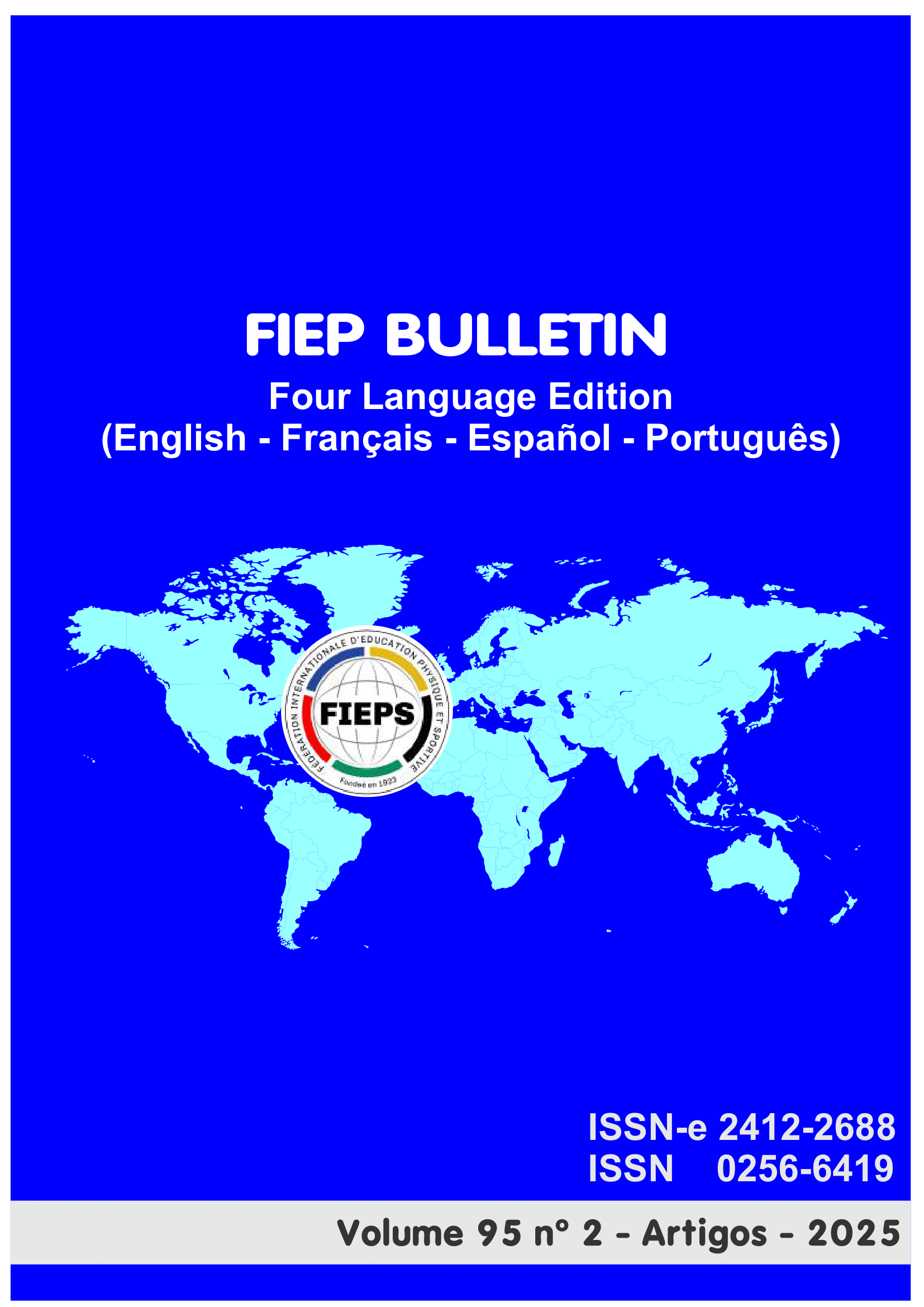ANÁLISE DA ESTRATÉGIA DE PROVA DOS ATLETAS FINALISTAS DOS 200 METROS COSTAS DOS JOGOS OLÍMPICOS E CAMPEONATOS MUNDIAIS DE 2009 A 2020
DOI:
https://doi.org/10.16887/zs9q9386Palavras-chave:
Natação, Desempenho atl´ético, EsportesResumo
Introdução: A natação é uma modalidade de característica contrarrelógio na qual o desempenho é mensurado pela capacidade do atleta nadar as distâncias no menor tempo possível. Nesse esporte, muitos fatores influenciam o desempenho esportivo, sendo a escolha da melhor estratégia de prova um fator essencial para que os atletas tenham sucesso. Objetivo: Investigar se a escolha da estratégia de prova tem relação com o desempenho dos atletas de elite em provas de 200 metros costas. Métodos: Os resultados de 18 provas (9 de atletas masculinos e 9 de atletas femininas) em nove eventos (três edições dos Jogos Olímpicos e seis campeonatos Mundiais de Natação) no período de 2009 a 2020, foram analisados. Resultados: Em ambas as categorias, os nadadores completaram a primeira volta mais rapidamente em relação às demais. Contudo, apenas nos homens houve uma diferença significativa entre o tempo da primeira volta e o total. Além disso, identificou-se uma correlação negativa na primeira metade da prova (100 metros) e positiva na segunda, para ambos os sexos. Conclusão: Os nadadores tendem a adotar uma estratégia positiva: iniciando com uma primeira volta rápida, seguida de uma diminuição de velocidade na segunda volta e um aumento nas últimas voltas, culminando em um sprint final. Essa estratégia é reconhecida na literatura como a mais eficaz, aproveitando vantagens como a respiração facilitada e a menor resistência da água. Esses achados oferecem subsídios para que treinadores possam integrar essa abordagem em seus treinos, visando melhorar os resultados de seus atletas.
Downloads
Referências
Abbiss, C. R., & Laursen, P. B. (2008). Describing and understanding pacing strategies during athletic competition. Sports Med, 38(3), 239-252. https://doi.org/10.2165/00007256-200838030-00004 DOI: https://doi.org/10.2165/00007256-200838030-00004
Ayres, M., Jr, M., Ayres, D. L., & Dos Santos, A. D. A. (2007). BIOESTAT – aplicações estatísticas nas áreas das Ciências Bio-Médicas.
Barbosa, T. M., Fernandes, R., Keskinen, K. L., Colaco, P., Cardoso, C., Silva, J., & Vilas-Boas, J. P. (2006). Evaluation of the energy expenditure in competitive swimming strokes. Int J Sports Med, 27(11), 894-899. https://doi.org/10.1055/s-2006-923776 DOI: https://doi.org/10.1055/s-2006-923776
Barroso, R., Crivoi, E., Foster, C., & Barbosa, A. C. (2021). How do swimmers pace the 400 m freestyle and what affects the pacing pattern? Res Sports Med, 29(6), 598-604. https://doi.org/10.1080/15438627.2020.1860051 DOI: https://doi.org/10.1080/15438627.2020.1860051
Damasceno, M., Correia-Oliveira, C. R., Narita, T., Pasqua, L., Bueno, S., Lima-Silva, A. E., & Bertuzzi, R. (2013). Estratégia adotada em provas de natação estilo crawl: uma análise das distâncias de 800 e 1500m [Pacing strategy adopted in crawl swimming competitions: an analysis of the 800-m and 1500-m distances]. Revista Brasileira de Cineantropometria & Desempenho Humano, 15(3), 361-370. https://doi.org/10.5007/1980-0037.2013v15n3p361 DOI: https://doi.org/10.5007/1980-0037.2013v15n3p361
Edwards, A. M., & Polman, R. C. (2013). Pacing and awareness: brain regulation of physical activity. Sports Med, 43(11), 1057-1064. https://doi.org/10.1007/s40279-013-0091-4 DOI: https://doi.org/10.1007/s40279-013-0091-4
Figueiredo, P., Zamparo, P., Sousa, A., Vilas-Boas, J. P., & Fernandes, R. J. (2011). An energy balance of the 200 m front crawl race. European Journal of Applied Physiology, 111(5), 767-777. https://doi.org/10.1007/s00421-010-1696-z DOI: https://doi.org/10.1007/s00421-010-1696-z
Hochstein, S., & Blickhan, R. (2014). Body movement distribution with respect to swimmer's glide position in human underwater undulatory swimming. Hum Mov Sci, 38, 305-318. https://doi.org/10.1016/j.humov.2014.08.017 DOI: https://doi.org/10.1016/j.humov.2014.08.017
Maglisho, E. W. (2010). Nadando o mais rápido possível. (Manole, Ed.).
Mauger, A. R., Neuloh, J., & Castle, P. C. (2012). Analysis of pacing strategy selection in elite 400-m freestyle swimming. Med Sci Sports Exerc, 44(11), 2205-2212. https://doi.org/10.1249/MSS.0b013e3182604b84 DOI: https://doi.org/10.1249/MSS.0b013e3182604b84
Menting, S. G. P., Elferink-Gemser, M. T., Huijgen, B. C., & Hettinga, F. J. (2019). Pacing in lane-based head-to-head competitions: A systematic review on swimming. J Sports Sci, 37(20), 2287-2299. https://doi.org/10.1080/02640414.2019.1627989 DOI: https://doi.org/10.1080/02640414.2019.1627989
Oliveira, G. T. d., Werneck, F. Z., Coelho, E. F., Simim, M. A. d. M., Penna, E. M., & Ferreira, R. M. (2019). What pacing strategy 800m and 1500m swimmers use? [Qual estratégia de prova que nadadores de 800m e 1500m usam?]. Revista Brasileira de Cineantropometria & Desempenho Humano, 21. https://doi.org/10.1590/1980-0037.2019v21e59851 DOI: https://doi.org/10.1590/1980-0037.2019v21e59851
Pyne, D., Trewin, C., & Hopkins, W. (2004). Progression and variability of competitive performance of Olympic swimmers. J Sports Sci, 22(7), 613-620. https://doi.org/10.1080/02640410310001655822 DOI: https://doi.org/10.1080/02640410310001655822
Skorski, S., Faude, O., Abbiss, C. R., Caviezel, S., Wengert, N., & Meyer, T. (2014). Influence of pacing manipulation on performance of juniors in simulated 400-m swim competition. Int J Sports Physiol Perform, 9(5), 817-824. https://doi.org/10.1123/ijspp.2013-0469 DOI: https://doi.org/10.1123/ijspp.2013-0469
Skorski, S., Faude, O., Rausch, K., & Meyer, T. (2013). Reproducibility of pacing profiles in competitive swimmers. Int J Sports Med, 34(2), 152-157. https://doi.org/10.1055/s-0032-1316357 DOI: https://doi.org/10.1055/s-0032-1316357
Veiga, S., Rodriguez, L., Gonzalez-Frutos, P., & Navandar, A. (2019). Race Strategies of Open Water Swimmers in the 5-km, 10-km, and 25-km Races of the 2017 FINA World Swimming Championships. Front Psychol, 10, 654. https://doi.org/10.3389/fpsyg.2019.00654 DOI: https://doi.org/10.3389/fpsyg.2019.00654
Veiga, S., & Roig, A. (2016). Underwater and surface strategies of 200 m world level swimmers. J Sports Sci, 34(8), 766-771. https://doi.org/10.1080/02640414.2015.1069382 DOI: https://doi.org/10.1080/02640414.2015.1069382
Wądrzyk, Ł., Staszkiewicz, R., & Strzała, M. (2022). Evaluating the Usefulness of the Modified Swimming Anaerobic Sprint Test (SAST) Based on the Relationship with the 100- and 200-m Freestyle. Applied Sciences, 12(15), 7566. https://doi.org/10.3390/app12157566 DOI: https://doi.org/10.3390/app12157566
Downloads
Publicado
Edição
Seção
Licença
Autores que publicam nesta revista concordam com os seguintes termos:- Autores mantém os direitos autorais e concedem à revista o direito de primeira publicação, com o trabalho simultaneamente licenciado sob a Licença Creative Commons Attribution que permite o compartilhamento do trabalho com reconhecimento da autoria e publicação inicial nesta revista.
- Autores têm autorização para assumir contratos adicionais separadamente, para distribuição não-exclusiva da versão do trabalho publicada nesta revista (ex.: publicar em repositório institucional ou como capítulo de livro), com reconhecimento de autoria e publicação inicial nesta revista.
- Autores têm permissão e são estimulados a publicar e distribuir seu trabalho online (ex.: em repositórios institucionais ou na sua página pessoal) a qualquer ponto antes ou durante o processo editorial, já que isso pode gerar alterações produtivas, bem como aumentar o impacto e a citação do trabalho publicado (Veja O Efeito do Acesso Livre).










